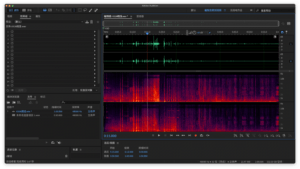- Concept
Briefly describe the memory you have chosen for the assignment. Which aspect of the memory (actual sounds, feelings, ideas, etc.) did you aim to convey to your audience? Discuss the thought process that brought you to the composition of your soundscape.
The memory I have chosen for the project is about the experience of going to learn Chinese calligraphy for the first time at 6. In fact I love this memory not for the soundscape, but for the whole atmosphere of the surroundings, which almost lay the foundation of my passion for calligraphy later. From the trip to my teacher’s home, to nervously knocking on the door, and encounter a peaceful place where almost everything was new to me. It is just because I was so curious and also strange about everything there, the tiny sound can be captured, no matter the sound of the steps, knocking, or brush, paper, ink stone, whisper and breath.
- Process
- Talk about the sounds you have used for the project and the reasons for the choice. Describe the recording techniques you have used and explain your choices. Did you encounter any problems? Tell us how you dealt with them.
- Explain your editing process. Describe challenges you faced, and solutions you found or compromises you decided to make. What are the learnings you are taking away?
At first, I only wanted to record the soundscape of practicing calligraphy, but found it so hard to do so, since the process itself is rather quiet with tiny sound that is rather difficult to record and identify as well. No matter I used a shot gun with windshield, a Tascam or my cell phone, it was hard to record a clear sound of turning pages, rubbing papers, as well as moving brushes on the paper. I adjusted several angles and methods for better effects.
Because of the difficulty I came across in the above step, I decided to include soundscape before starting practicing. I added some sound elements of old neighborhood, including the rusty iron gate, the lightly echoing staircase, etc. I recall hearing the low whisper from older school kids at that time, in another end of the room, but found it hard to reshow it, since the kids I spent long time to find were all laughing and shouting quite loud.
I understand I didn’t have a very good raw material for my project, so I just put my hope on editing the sound effect. Adding reverberation or echoing sound as well as lowing the volume was also a method to modify the speaking sound. I also use changes in the left and right audio tracks to enhance the sense of spatial change as one enters the building from the outside. For example, after entering the door of the unit, the noise of the street diminishes, the iron door closes heavily behind and swings a few times, and the sound of the iron door gradually fades with the clear sound of climbing stairs.
- Conclusion
How would you improve your project if you had more time?
At presentation day: Did you receive feedback that informs further steps you would like to take? Explain how your work was perceived by others, and reflect on their feedback.
I would say I did not see my work as a very artistic one, but more like one thing that is able to bring me back to my memory. But as this is a school project which is not merely viewed and critiqued by me, I think it needs more edition on stressing the identity of main figure, a 6-year old kid.
- Image of Audition

